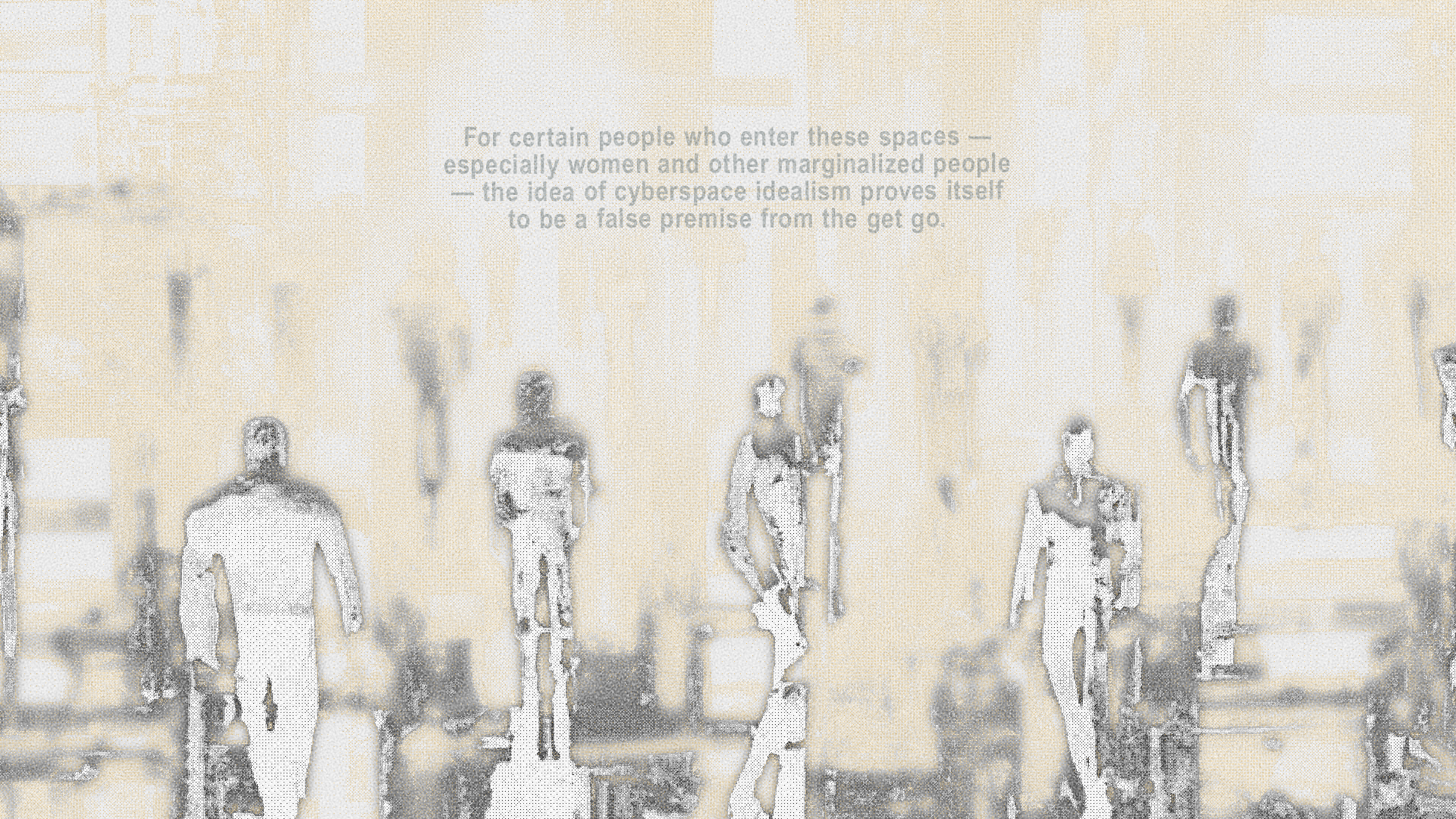- Ariel LeBeau
- Austin Robey
- David Blumenstein
- David Ehrlichman
- David Kerr
- Devon Moore
- Dexter Tortoriello
- Drew Coffman
- Drew Millard
- Eileen Isagon Skyers
- FWB Staff
- Greg Bresnitz
- Greta Rainbow
- Ian Rogers
- Jessica Klein
- Jose Mejia
- Kelani Nichole
- Kelsie Nabben
- Kevin Munger
- Khalila Douze
- Kinjal Shah
- Lindsay Howard
- Maelstrom
- Marc Moglen
- Marvin Lin
- Mary Carreon
- Matt Newberg
- Mike Pearl
- Moyosore Briggs
- Nicole Froio
- Ruby Justice Thelot
- Simon Hudson
- Steph Alinsug
- The Blockchain Socialist
- Willa Köerner
- Yana Sosnovskaya
- Yancey Strickler

Wed Sep 14 2022

For Donna Haraway, technology had the potential to expand our existence beyond the body. This was particularly exciting for (cisgender) women, she argued, whose biology, burdened by the constructions of motherhood, often defined the destiny and purpose of their lives: “Up till now,” she wrote in her groundbreaking “Cyborg Manifesto” essay, “female embodiment seemed to mean skill in mothering and its metaphoric extensions.” By comparison, she argued, cyborgs could “suggest a way out of the maze of dualisms” — male or female, Black or white, straight or gay — “in which we have explained our bodies and our tools to ourselves.”
Cyberspace, Haraway posited, made it possible for feminized bodies to exist beyond their skin, thereby overcoming the roles and violences imposed on them. Her idea of a feminist cyborg posited that by reinventing ourselves in cyberspace, we could theoretically transcend the societal constructions structures of gender, race, disability, and capitalist oppression. In this way, Haraway was perhaps one of the internet’s earliest advocates of what scholar Mary Anne Franks has termed cyberspace idealism: “the view of cyberspace as a utopian realm of the mind where all can participate equally, free from social, historical, and physical restraints.”
In 2022, it seems that Haraway was partly correct: Widespread adoption of cyberspace does mean our existence goes beyond the physical. There’s a vivid, ongoing history of marginalized people finding places of belonging on social media, within gaming spaces, and even in the metaverse. Our digital existences, along with the communities we find online, allow us to experiment with identities and parts of ourselves we might not be able to explore in our real lives.
Unfortunately, so far cyberspace has done little to liberate people from societal expectations, gender-based violence, and forms of discrimination like racism, homophobia, transphobia, and ableism. Instead of transcending corporeality through cybernetical self-recreation, women and gender diverse people in cyberspace have often been turned into what Franks calls “unwilling avatars,” targets for myriad forms of cyber harassment including revenge porn, doxxing, identity theft, and impersonation. In a 2011 essay for the Columbia Journal of Gender and Law, Franks characterizes this gendered violence as a “second loss [of liberty that compounds] the effects of offline subordination.” She reminds readers that many women go online to escape the effects of gendered violence, only to be confronted with new forms of it in cyberspace.
The metaverse, which has largely been framed in the language of cyberspace idealism by corporations and start-ups alike, is proving to be no different. Meta’s VR social media platform Horizon Worlds, a free virtual reality game where users explore and build different worlds with avatar-like bodies, was home to an alleged groping incident during beta testing in late 2021, according to The Verge. Shortly thereafter, a metaverse researcher named Nina Jane Patel published an essay saying her avatar was “virtually gang raped” by a group of three or four male-presenting avatars within 60 seconds of logging on to the platform.
Meta, which is also the parent company of Facebook, has an official conduct in VR policy as well as guidelines around content. Since at least as far back as 2020, it has been developing tools that allow people to block, mute, or report other players, in addition to a feature called “Safe Zone,” a protective bubble users can activate inside the VR environment if they feel threatened. When this feature is activated, no one can touch, talk, or interact with them in any way until the Safe Zone is lifted. A few months after Patel shared her story, in February 2022, the company also introduced a customizable personal boundary feature that prevents people from entering another user’s personal space. It currently sets the default distance between users at approximately four feet.
These tools are an important start, but they aren’t fail-safe. In May of this year, researchers from the global non-profit advocacy organization SumOfUs.org entered Meta-owned VR environments to conduct an independent study on interactions within these spaces. They noted that they were “astonished by how quickly they encountered sexual harassment,” with one researcher alleging that her avatar was sexually assaulted after another user persuaded her to disable the boundary feature. When reached for comment, a spokesperson for Meta pointed us to statements in which the company acknowledged these incidents and stressed its commitment to improving its user interface and making Horizons World a safe place for everyone. Along with reports of similar experiences on platforms like Rec Room and VR Chat, though, these stories are a chilling reminder that for certain people who enter these environments — especially women and other marginalized people — the idea of cyber-idealism can reveal itself to be a false premise from the get-go.
In her piece about unwilling avatars, Franks argues that prejudice against women in digital spaces challenges the idea that cyberspace can constitute or result in a utopia. “Specifically, the idealist view fails to recognize — or at least to take seriously — how the same features of cyberspace that amplify the possibilities of individual liberty also amplify the potential for discrimination,” she writes. A world in which everyone is ostensibly free to do as they please, in other words, can give rise to behaviors that result in a lack of liberty for marginalized groups. “Cyberspace idealism drastically downplays the internet's power to activate discriminatory stereotypes and social scripts,” she writes.
Franks’ piece was published at the turn of the last decade, a time when VR technology was far less sophisticated than it is in 2022. But as cyberspace and metaverse spaces become more and more immersive, her words feel increasingly urgent. The VR companies of today promise us cutting-edge, adventure-filled experiences, the seductive image of a utopic, liberatory space that can save us from the worsening state of human reality. But if we cling to the notion of cyberspace idealism, whose experiences in these spaces are we choosing to ignore?

Gendered violence in VR is not a new phenomenon. In his 1993 essay “A Rape in Cyberspace,” American author and technology journalist Julian Dibbell describes a disturbing series of incidents in the text-based online virtual reality system LambdaMOO. A user named Mr. Bungle had used a tool called “Voodoo power” to control other users’ avatars and commit virtual rapes of several female-presenting characters and one character of indeterminate gender. The essay details the debates that followed in the LambdaMOO community regarding the consequences Mr. Bungle should face and what, if anything, could be done to prevent such incidents from happening in the future.
Technolibertarians were against booting the user from the game, arguing, according to Dibbell, that “the presence of assholes on the system was a technical inevitability.” Other users called for Mr. Bungle to be banned from the platform. But because the assaults had happened to avatars in a virtual world, people’s positions on the matter seemed to hinge on whether they thought the violence was “real,” or whether it had real-life consequences.
Ironically, conversations about gendered violence in cyberspace tend to mirror some of the more noxious ways that we talk about these incidents in the offline world. For decades, discussions of sexual harassment have circled around a perceived dichotomy between physical and psychological harm, with anti-feminist detractors dismissing or minimizing verbal violence against women as less damaging than physical attacks. Ultimately, the discourse has been stuck on a question: “Is the harm of verbal misogyny real?”
Legally speaking, sexual violence in cyberspace is something of an uncharted territory. Under U.S. law, the charge of sexual assault requires a physical component, and there’s little precedent for classifying forms of violence that are experienced by an avatar online. Nonetheless, according to employment attorney Timothy Taylor, legal scholars generally fall back on one or two competing frameworks when discussing the phenomenon. The first has generally framed sexual misconduct in VR environments using the language of sexual assault, meaning that it is understood as real violence, akin to a physical violation. The second has focused on criticizing this framework, claiming that though what happens in the metaverse might feel real, it isn’t actually real, because an avatar is not actually your body.
Taylor challenges the second framework, arguing that it “incorrectly dismisses the psychological harms and objectively offensive aspects of sexual misconduct in the metaverse.” Perhaps a better legal framework for sexual misconduct in the metaverse, he suggests, is the category of sexual harassment, which in U.S. law refers to unwelcome communications, gestures, and depictions of a sexual nature — and focuses primarily on whether or not an interaction is non-consensual, rather than the physicality of the act. It’s easy, however, to see limitations with this approach: One of them is that immersive VR environments are increasingly being designed to feel real. Artificial touch technology, for example, opens up the possibility of a future where gendered harm in cyberspace is experienced in a physical manner. At what point will it become impossible to draw a clear line between violence enacted through technology and a physical violation?
Of course, Taylor’s analysis is based on a corporate protection perspective rather than a survivor-centered one. While finding the right legal frameworks for gendered violence in cyberspace is essential for giving survivors a path toward justice and encouraging platforms to keep people safe, this only tackles the problem after the fact. And just like in real life, none of these frameworks necessarily address aspects of the experience that go beyond the violent event itself. For example, they do little to redress survivors’ subsequent exclusion from digital environments due to feeling unsafe. Law professor Danielle Keats Citron, an expert on privacy, free speech, and civil procedure, has likened this exclusion to a new form of structural violence, one that “limits opportunity and exacts a significant cost.”
The question, it seems, shouldn’t be how real digital violence feels, but rather the extent to which it further entrenches very real inequalities. Franks is firm about this in her essay. Often, she argues, discussions about digital gendered harm in the legal field focus on harm done to individuals, thereby downplaying what should be central to the discussion: its impact on women as a group, along with other marginalized genders. Cyber harassment, she writes, “is a form of collective discrimination and should be treated as such.”
After decades of Web2 companies failing to prevent these kinds of incidents, digital gendered harm can no longer be chalked up to simple design flaws. Like racism and homophobia, these are societal problems that will inevitably rear their head in cyberspace. And this is where the idealist rhetoric at the heart of the metaverse industry might be impeding developers rather than helping.
For Sydette Harry, a digital researcher and theorist, the utopian rhetoric being used by developers in Web3 and metaverse spaces is disappointing. “Everything in Web2 is going to move to Web3, and any pretense that it won’t is my biggest concern with all technological prognostications,” Harry said. “The claims that Web3 will stop the divisions, vices, and decentralize [our society] are great [marketing] copy. However, building that must be intentional and open — and the way the advertised versions of Web3 have operated don’t reflect that.”

To make cyberspace safe for women and other marginalized genders, we need to build these spaces from the perspective of the people who are most likely to feel alienated within them. To do so, we need to set aside the question of physical versus psychological impact, says Aaron Stanton, director of the VR Institute of Health and Exercise. It doesn’t just oversimplify and invalidate the experiences of survivors; it limits the imagination of developers when it comes to finding solutions.
Stanton first became concerned with sexual violence in VR environments in October of 2016, when gamer Jordan Belamire published an account of being groped in the game Quivr, which Stanton had co-designed. The incident, which sparked some social media debate in the video game industry about whether harassment in gaming communities should be considered “real” harm, was impactful for Stanton, who believes the conversation at the time was not entirely constructive.
“I think that any argument that VR harassment isn’t real shows a poor understanding of why such encounters can be so painful,” Stanton said. “Certainly, there is a physical component to real-world encounters that is missing for the virtual one, but there’s a lot more to harassment and sexual assault than just the physical. There’s control, dominance, a sense of powerlessness — all these are parts of what makes these experiences traumatic.”
Instead of focusing on the dichotomy between the physical and the virtual, Stanton believes that developers should be imagining what VR can do that transcends physical boundaries. He shared an example of a moment when he felt powerless in his own life: getting shoved by a school bully in high school. “What would have happened had I been a superhero?” he said. “Instead of me falling down when the bully shoved me, [what if] my hair went bright white and [I started] flying in the air — like a Super Saiyan powering up in Dragon Ball Z?” Though it’s a bit of a silly thought experiment, it’s the kind of questioning that opens up new avenues for developers: What if, instead of introducing a “safety bubble,” or obliging survivors to step away from the VR environment, the tech was designed to be empowering to the survivor who is under attack?
For example, Stanton says, VR environments could enable users to deploy something called a “universal power gesture,” which would signal to community admins and safety specialists that something is wrong and they need help. This is something Stanton and his colleagues developed at Quivr, and they even made it open source, so that other developers could easily add it to their environments and games. Ideally, he says, such features are designed to help the player feel more in control of the situation.
“The developer does whatever they can in the context of the game to make the player feel super powerful, as if nothing can hurt them,” Stanton explained. “Their character grows to 100 feet tall, and they can flick a finger and fling the harasser, now the size of my pinky, into the distance. Or the power gesture [lets you] burst energy all around you in a wave, blowing away anyone close to you, so you have your personal bubble, but it’s dramatic and strong.”
According to Stanton, we are so focused on whether online violence is “real,” that we aren’t taking advantage of the possibilities VR gives us to do the things we wish we could do when we feel powerless in real life.
Perhaps Haraway’s dream of transcending the physical body through cyberspace — in a utopian, feminist way — wasn’t so shortsighted after all. Though gender-based violence can feel inescapable on the internet, that doesn’t mean that the technology for empowerment and transcendence isn’t there. Changing the status quo requires the imagination and determination to make cyberspace more utopian, rather than assuming that cyberspace is a utopia unto itself.
Nicole Froio is a reporter, researcher, and translator based in Rio de Janeiro, Brazil. She has a Masters in Women's Studies and has covered sexual violence for almost 10 years.
Images by Carlos Sanchez


